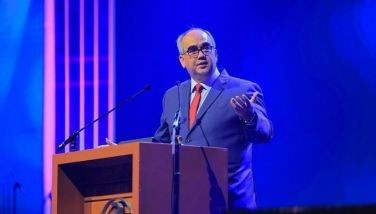Field of dreams
August 13, 2003 | 12:00am
Are wireless "hotspots" a hot business?
In the movie "Field of Dreams" James Earl Jones’ character says "build it and they will come". Many potential entrepreneurs, Internet service providers (ISPs) and telecommunications companies feel that way about a landmark National Telecommunications Commission (NTC) memorandum order to be released within the month.
According to the draft order, even private companies will be able to offer Internet service using their own wireless network, an apparent exception to section 11 of RA 7925 provided they are "indoor devices" with a range of 400 meters or less. Previously a privilege limited to companies who secured a congressional franchise to provide telecom services, potential users will have opportunities to set up their own networks and bypass the expensive services of telecommunication firms.
To make it more attractive to private users, NTC even proposes that it will charge private users lower fees that it will charge telecom companies.
WiFi generically refers to a technology used for wireless local area networking that becomes wide area or even global through access to the Internet. These are further classified into Personal Area Network (less than 10 meters range), LAN (less than 400 meters range) and WAN (greater than 400 meters range). Globally the frequencies 2.4 GHz and 5.7 GHz are used for these systems.
Users purchase wireless LAN cards or access devices which use a number of technologies and frequencies with different prices. The most economical and common is 802.11b on 2.4 GHz with cards available for as low as P2,000. Operators set up an Access Point with an Internet connection through a leased line, DSL or through wireless broadband. Access to the system is controlled either through an encryption code and/or a user name and password. Users can have peak speeds of up to 22 Megabits per second limited only by the speed of the Internet connection (however, this is generally only 256Kbps or less).
The circular will also lift the ban on using the 2.4 GHz frequency band. Although the most popular frequency band in the world because of it’s low cost, previous use of the frequency was restricted. It was reserved for the exclusive use of Meralco in NCR as well as Regions 3 and 4 for the operation of their Supervisory Control And Data Access (SCADA) system which controls and monitors Meralco’s substations to ensure load balancing and minimize brownouts. In the past, unlawful use of the frequency had caused a number of power outages.
Telecom companies are against provisions of the proposed Memorandum Order because it will allow private companies to set up their own networks and bypass the systems and infrastructure setup by the Telcos. For instance, telecom companies charge as much as P41,000 a month for an E-1 (2.048 Mbps) connection while a private company using WiFi can set up a 22Mbps network for a one-time fee of only P25,000.
On the other hand, ISPs and IT companies support the memorandum because it will allow them to be more competitive. Generally telecom costs represent more than 50 percent of an ISP’s costs. Industry players say that high telecom cost is the main reason why more than 70 percent of ISPs have closed in the last three years.
Equipment vendors such as Intel, Nokia and Cisco are quite excited because the lifting of the 2.4 GHz frequency ban will now allow them to legally sell their products which were previously banned in the Philippines, but were available in the rest of the world.
Potential operators set up a network by purchasing an access point and subscribing to an Internet service. They then must have an access control server which will assign users an encryption key to prevent hacking and monitor their usage for billing purposes. Billing is done either through a prepaid card or a network timer. Potentially users could bring a laptop computer or palm device and have high speed access anywhere there is a hotspot.
However, some players have their doubts about the long term profitability of such a business model. Most Filipinos do not have a laptop and most that do, do not take them to commercial establishments for fear of them being stolen or their data being erased by a metal detector (yes Virginia, that innocent looking wand can magnetize all your data). The majority by far prefer to use an Internet cafe and not carry around any hardware aside from their cellphone. Restaurant owners with hotspots complain about long hold periods and fewer turns from users who take up a whole table, don’t order food and don’t bring in additional revenue.
Other places claim they get better customer loyalty and customers even during the off peak periods. Like Kevin Costner in "Field of Dreams" we can take a leap of faith, because we’ll never find out until it’s actually built.
For comments, e-mail at HYPERLINK "mailto:rmaryannl@yahoo.com" rmaryannl@yahoo.com
In the movie "Field of Dreams" James Earl Jones’ character says "build it and they will come". Many potential entrepreneurs, Internet service providers (ISPs) and telecommunications companies feel that way about a landmark National Telecommunications Commission (NTC) memorandum order to be released within the month.
According to the draft order, even private companies will be able to offer Internet service using their own wireless network, an apparent exception to section 11 of RA 7925 provided they are "indoor devices" with a range of 400 meters or less. Previously a privilege limited to companies who secured a congressional franchise to provide telecom services, potential users will have opportunities to set up their own networks and bypass the expensive services of telecommunication firms.
To make it more attractive to private users, NTC even proposes that it will charge private users lower fees that it will charge telecom companies.
WiFi generically refers to a technology used for wireless local area networking that becomes wide area or even global through access to the Internet. These are further classified into Personal Area Network (less than 10 meters range), LAN (less than 400 meters range) and WAN (greater than 400 meters range). Globally the frequencies 2.4 GHz and 5.7 GHz are used for these systems.
Users purchase wireless LAN cards or access devices which use a number of technologies and frequencies with different prices. The most economical and common is 802.11b on 2.4 GHz with cards available for as low as P2,000. Operators set up an Access Point with an Internet connection through a leased line, DSL or through wireless broadband. Access to the system is controlled either through an encryption code and/or a user name and password. Users can have peak speeds of up to 22 Megabits per second limited only by the speed of the Internet connection (however, this is generally only 256Kbps or less).
The circular will also lift the ban on using the 2.4 GHz frequency band. Although the most popular frequency band in the world because of it’s low cost, previous use of the frequency was restricted. It was reserved for the exclusive use of Meralco in NCR as well as Regions 3 and 4 for the operation of their Supervisory Control And Data Access (SCADA) system which controls and monitors Meralco’s substations to ensure load balancing and minimize brownouts. In the past, unlawful use of the frequency had caused a number of power outages.
Telecom companies are against provisions of the proposed Memorandum Order because it will allow private companies to set up their own networks and bypass the systems and infrastructure setup by the Telcos. For instance, telecom companies charge as much as P41,000 a month for an E-1 (2.048 Mbps) connection while a private company using WiFi can set up a 22Mbps network for a one-time fee of only P25,000.
On the other hand, ISPs and IT companies support the memorandum because it will allow them to be more competitive. Generally telecom costs represent more than 50 percent of an ISP’s costs. Industry players say that high telecom cost is the main reason why more than 70 percent of ISPs have closed in the last three years.
Equipment vendors such as Intel, Nokia and Cisco are quite excited because the lifting of the 2.4 GHz frequency ban will now allow them to legally sell their products which were previously banned in the Philippines, but were available in the rest of the world.
Potential operators set up a network by purchasing an access point and subscribing to an Internet service. They then must have an access control server which will assign users an encryption key to prevent hacking and monitor their usage for billing purposes. Billing is done either through a prepaid card or a network timer. Potentially users could bring a laptop computer or palm device and have high speed access anywhere there is a hotspot.
However, some players have their doubts about the long term profitability of such a business model. Most Filipinos do not have a laptop and most that do, do not take them to commercial establishments for fear of them being stolen or their data being erased by a metal detector (yes Virginia, that innocent looking wand can magnetize all your data). The majority by far prefer to use an Internet cafe and not carry around any hardware aside from their cellphone. Restaurant owners with hotspots complain about long hold periods and fewer turns from users who take up a whole table, don’t order food and don’t bring in additional revenue.
Other places claim they get better customer loyalty and customers even during the off peak periods. Like Kevin Costner in "Field of Dreams" we can take a leap of faith, because we’ll never find out until it’s actually built.
For comments, e-mail at HYPERLINK "mailto:rmaryannl@yahoo.com" rmaryannl@yahoo.com
BrandSpace Articles
<
>
- Latest
- Trending
Trending
Latest
Trending
Latest
Recommended




























